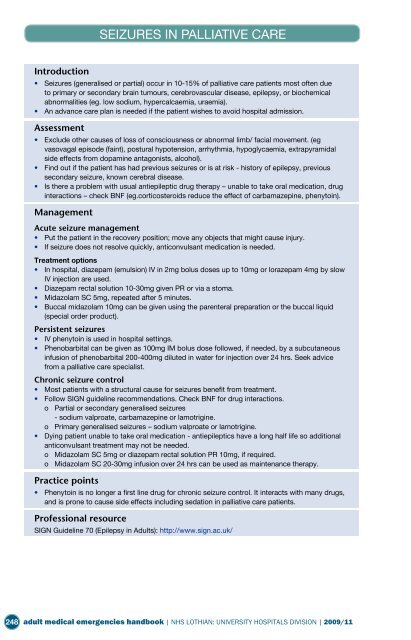Adult Medical Emergency Handbook - Scottish Intensive Care Society
Adult Medical Emergency Handbook - Scottish Intensive Care Society
Adult Medical Emergency Handbook - Scottish Intensive Care Society
You also want an ePaper? Increase the reach of your titles
YUMPU automatically turns print PDFs into web optimized ePapers that Google loves.
SEIZURES IN PALLIATIVE CARE<br />
Seizures in Palliative <strong>Care</strong><br />
Introduction<br />
• Seizures (generalised or partial) occur in 10-15% of palliative care patients most often due<br />
to primary or secondary brain tumours, cerebrovascular disease, epilepsy, or biochemical<br />
abnormalities (eg. low sodium, hypercalcaemia, uraemia).<br />
• An advance care plan is needed if the patient wishes to avoid hospital admission.<br />
Assessment<br />
• Exclude other causes of loss of consciousness or abnormal limb/ facial movement. (eg<br />
vasovagal episode (faint), postural hypotension, arrhythmia, hypoglycaemia, extrapyramidal<br />
side effects from dopamine antagonists, alcohol).<br />
• Find out if the patient has had previous seizures or is at risk - history of epilepsy, previous<br />
secondary seizure, known cerebral disease.<br />
• Is there a problem with usual antiepileptic drug therapy – unable to take oral medication, drug<br />
interactions – check BNF (eg.corticosteroids reduce the effect of carbamazepine, phenytoin).<br />
Management<br />
Acute seizure management<br />
• Put the patient in the recovery position; move any objects that might cause injury.<br />
• If seizure does not resolve quickly, anticonvulsant medication is needed.<br />
Treatment options<br />
• In hospital, diazepam (emulsion) IV in 2mg bolus doses up to 10mg or lorazepam 4mg by slow<br />
IV injection are used.<br />
• Diazepam rectal solution 10-30mg given PR or via a stoma.<br />
• Midazolam SC 5mg, repeated after 5 minutes.<br />
• Buccal midazolam 10mg can be given using the parenteral preparation or the buccal liquid<br />
(special order product).<br />
Persistent seizures<br />
• IV phenytoin is used in hospital settings.<br />
• Phenobarbital can be given as 100mg IM bolus dose followed, if needed, by a subcutaneous<br />
infusion of phenobarbital 200-400mg diluted in water for injection over 24 hrs. Seek advice<br />
from a palliative care specialist.<br />
Chronic seizure control<br />
• Most patients with a structural cause for seizures benefit from treatment.<br />
• Follow SIGN guideline recommendations. Check BNF for drug interactions.<br />
o Partial or secondary generalised seizures<br />
- sodium valproate, carbamazepine or lamotrigine.<br />
o Primary generalised seizures – sodium valproate or lamotrigine.<br />
• Dying patient unable to take oral medication - antiepileptics have a long half life so additional<br />
anticonvulsant treatment may not be needed.<br />
o Midazolam SC 5mg or diazepam rectal solution PR 10mg, if required.<br />
o Midazolam SC 20-30mg infusion over 24 hrs can be used as maintenance therapy.<br />
Practice points<br />
• Phenytoin is no longer a first line drug for chronic seizure control. It interacts with many drugs,<br />
and is prone to cause side effects including sedation in palliative care patients.<br />
Professional resource<br />
SIGN Guideline 70 (Epilepsy in <strong>Adult</strong>s): http://www.sign.ac.uk/<br />
248 adult medical emergencies handbook | NHS LOTHIAN: UNIVERSITY HOSPITALS DIVISION | 2009/11


